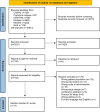Use of peripherally inserted central venous catheters and midline catheters for palliative care in patients with cancer: a systematic review
- PMID: 38926160
- PMCID: PMC11208250
- DOI: 10.1007/s00520-024-08664-3
Use of peripherally inserted central venous catheters and midline catheters for palliative care in patients with cancer: a systematic review
Abstract
Background: Peripherally inserted central catheters (PICCs) and midline catheters (MCs) may offer convenient intravenous access, but evidence to support their place in palliative care is limited. This review aimed to assess catheter indications, utilization, complications, dwell time, and patient experiences in cancer patients receiving palliative care.
Methods: A systematic search for studies on catheter utilization for supportive or symptom treatment was conducted in Medline, Embase, CINAHL, Web of Science, Cochrane, and CENTRAL databases. Studies with a study population or a subgroup of palliative care cancer patients were included. Study quality was assessed using the Effective Public Health Practice Quality assessment tool.
Results: Of 7631 unique titles, 17 articles were examined in detail, all published between 2002 and 2022. Median catheter dwell time varied from 15 to 194 days, the longest when utilized for home parenteral nutrition. For pain and symptom management, the typical duration was 2-4 weeks, often until the patient's death. Complication rates were minimal, with thrombosis, infections, and occlusion ranging from 0 to 2.46 incidents per 1000 catheter days. In studies from palliative care services, patients reported minimal distress during procedures and high user satisfaction. Quality of life assessments post-procedure improved, possibly influenced by concurrent specialist palliative care provision. All studies were assessed to be of moderate or weak quality.
Conclusion: PICC and MC are safe and valuable tools in palliative care cancer patients who would benefit from intravenous access for symptom management. Further studies are needed to clarify indications for PICC or MC in palliative care.
Keywords: Cancer; Drug administration; Intravenous access; Midline catheter; Palliative care; Peripherally inserted central catheter.
© 2024. The Author(s).
Conflict of interest statement
The authors declare no competing interests.
The authors declare no competing interests.
Figures
References
-
- Fallon M, Giusti R, Aielli F, Hoskin P, Rolke R, Sharma M, et al. Management of cancer pain in adult patients: ESMO Clinical Practice Guidelines. Ann Oncol. 2018;29(Suppl 4):iv166-iv91. 10.1093/annonc/mdy152 - PubMed
-
- National Clinical Guideline Centre (UK) (2015) Care of dying adults in the last days of life. (NICE Guideline, No. 31). National Institute for Health and Care Excellence (NICE), London. https://www.ncbi.nlm.nih.gov/books/NBK338140/ - PubMed
-
- Dale O, Thoner J, Nilsen T, Tveita T, Borchgrevink PC, Klepstad P. Serum and cerebrospinal fluid morphine pharmacokinetics after single doses of intravenous and intramuscular morphine after hip replacement surgery. Eur J Clin Pharmacol. 2007;63(9):837–842. doi: 10.1007/s00228-007-0329-x. - DOI - PubMed
-
- Tveita T, Thoner J, Klepstad P, Dale O, Jystad A, Borchgrevink PC. A controlled comparison between single doses of intravenous and intramuscular morphine with respect to analgesic effects and patient safety. Acta Anaesthesiol Scand. 2008;52(7):920–925. doi: 10.1111/j.1399-6576.2008.01608.x. - DOI - PubMed
-
- Bortolussi R, Zotti P, Conte M, Marson R, Polesel J, Colussi A, et al. Quality of life, pain perception, and distress correlated to ultrasound-guided peripherally inserted central venous catheters in palliative care patients in a home or hospice setting. J Pain Symptom Manage. 2015;50(1):118–123. doi: 10.1016/j.jpainsymman.2015.02.027. - DOI - PubMed
Publication types
MeSH terms
LinkOut - more resources
Full Text Sources
Medical


